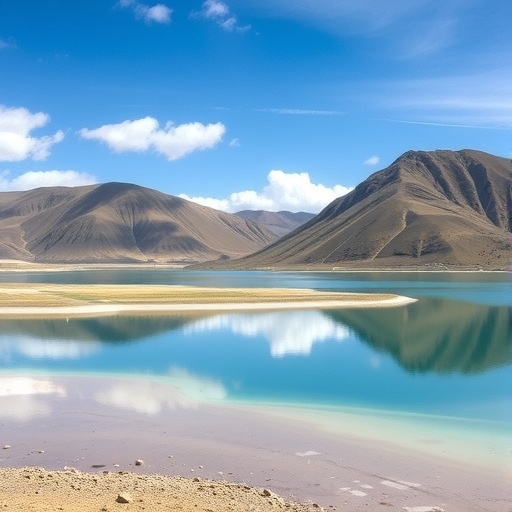On the Qinghai-Tibet Plateau, a significant and often overlooked aspect of carbon cycling has come to light, changing the way we understand environmental dynamics in this vast region. Recent research conducted by a team of scientists highlights the crucial role of large alkaline lakes in the net sequestration of carbon dioxide, underscoring their vital function in regulating carbon exchanges. This revelation is important not only for ecological research but also for climate science, as these lakes may act as natural carbon sinks that help mitigate atmospheric CO2 levels.
In the context of global climate change, understanding carbon exchange processes is critical for formulating strategies to reduce greenhouse gas concentrations in the atmosphere. The study conducted by Li and colleagues provides empirical evidence that these large alkaline lakes, by sequestering substantial amounts of carbon dioxide, might play a dominant role in balancing the carbon budget of the Qinghai-Tibet Plateau. What was once considered merely a regional phenomenon now surfaces as a significant player in the global ecosystem.
The research meticulously analyzed various lakes across the Qinghai-Tibet Plateau, exploring their unique chemical compositions and the effects these have on carbon dynamics. It has been established that the high alkalinity of these lakes contributes to a unique process of carbon dioxide absorption and storage. By assessing dissolved inorganic carbon levels and productivity metrics, the researchers could derive a clear picture of the lakes’ contributions to atmospheric exchanges, painting a vivid portrait of their ecological importance.
One of the key findings from this research is the discernible difference in carbon fixation capabilities between alkaline lakes and other freshwater systems. The authors discovered that the unique ionic composition of these lakes promotes higher rates of carbon consumption. As a result, large alkaline lakes emerge as exceptional buffers against increasing atmospheric CO2 levels, functioning as a reservoir for carbon over extended periods. This discovery suggests a landscape that can actively combat climate change, diminishing the concerns surrounding rising greenhouse gases.
Another critical aspect of the research involved the interaction between biological and chemical processes within these lakes. The study underscored the synergy between biological productivity—namely photosynthesis from aquatic flora—and the lake’s chemical characteristics. This synergy results in a feedback loop that enhances carbon sequestration capabilities. Such a dynamic illustrates the interconnectedness of various ecological processes, emphasizing the necessity for comprehensive studies that factor in both biotic and abiotic components of ecosystems when assessing carbon exchanges.
As the consequences of global warming become more pronounced, understanding the mechanisms that drive carbon sequestration in unique environments like the Qinghai-Tibet Plateau’s lakes becomes paramount. The findings from this study underscore the importance of protecting these ecosystems, not just for their intrinsic ecological values but also as vital players in our fight against climate change. Ensuring the ecological health of these lakes will have direct implications for their capacity to sequester carbon and thus ameliorate climate change impacts.
In addition to their carbon sequestration abilities, large alkaline lakes serve as critical habitats for various species of wildlife, particularly migratory birds and diverse aquatic life. The research indicates that the ecological value of these lakes is multifaceted, presenting opportunities for biodiversity preservation alongside their role in carbon cycling. This revelation opens up new dialogues around conservation strategies that can integrate ecological sustainability with climate action initiatives.
Moreover, the implications of this research extend to global policy frameworks concerning climate change mitigation. While efforts to combat climate change often focus on reducing emissions from industrial sources, the findings remind us of the importance of natural ecosystems as vital allies in this process. Restoration and conservation efforts should now incorporate the enhancement of natural carbon sinks like those found in the Qinghai-Tibet Plateau to create a more holistic approach to climate strategies.
With the looming challenges posed by climate change, research like Li et al.’s study empowers global communities to recognize and leverage the critical services provided by natural systems. Mobilizing support for conservation projects centered around these unique lakes can catalyze initiatives that prioritize both environmental and community resilience.
Furthermore, the study highlights a significant gap in current climate research — the understanding of regional ecosystems like the Qinghai-Tibet Plateau. Without comprehensive research, areas that could play significant roles in carbon sequestration may receive inadequate protection or funding. The importance of further studies cannot be overstated, as they have the potential to discover new natural processes previously unknown to science.
In conclusion, the findings of this study by Li and colleagues offer a refreshing perspective on the role of large alkaline lakes in carbon sequestration within the Qinghai-Tibet Plateau. The ramifications are profound, suggesting that conserving and studying these unique systems could yield considerable benefits in the fight against climate change. By integrating ecological understanding into climate policy and community strategies, we can harness the power of nature — transforming our perception of how ecosystems and climate interlink and paving the way for a more sustainable future.
As we move forward, it’s vital to raise awareness about the importance of these lakes and to engage in dialogues on how best to implement protective measures. The compelling evidence from this research calls for significant attention from scholars, policymakers, and conservationists alike, urging all stakeholders to recognize and support the natural systems that work tirelessly to sustain our planet.
The future of our climate may hinge on taking a closer look at regions like the Qinghai-Tibet Plateau, encouraging more research that will illuminate the intricate dynamics of carbon exchange across these fascinating and diverse landscapes.
Subject of Research: Carbon dioxide sequestration by alkaline lakes in the Qinghai-Tibet Plateau.
Article Title: Net carbon dioxide sequestration by large alkaline lakes dominates the carbon exchange of Qinghai-Tibet Plateau lakes.
Article References:
Li, Y., Wang, G., Sun, S. et al. Net carbon dioxide sequestration by large alkaline lakes dominates the carbon exchange of Qinghai-Tibet Plateau lakes. Commun Earth Environ 6, 952 (2025). https://doi.org/10.1038/s43247-025-02884-z
Image Credits: AI Generated
DOI: https://doi.org/10.1038/s43247-025-02884-z
Keywords: Carbon sequestration, Qinghai-Tibet Plateau, alkaline lakes, climate change, carbon budget, biodiversity, ecological conservation.




